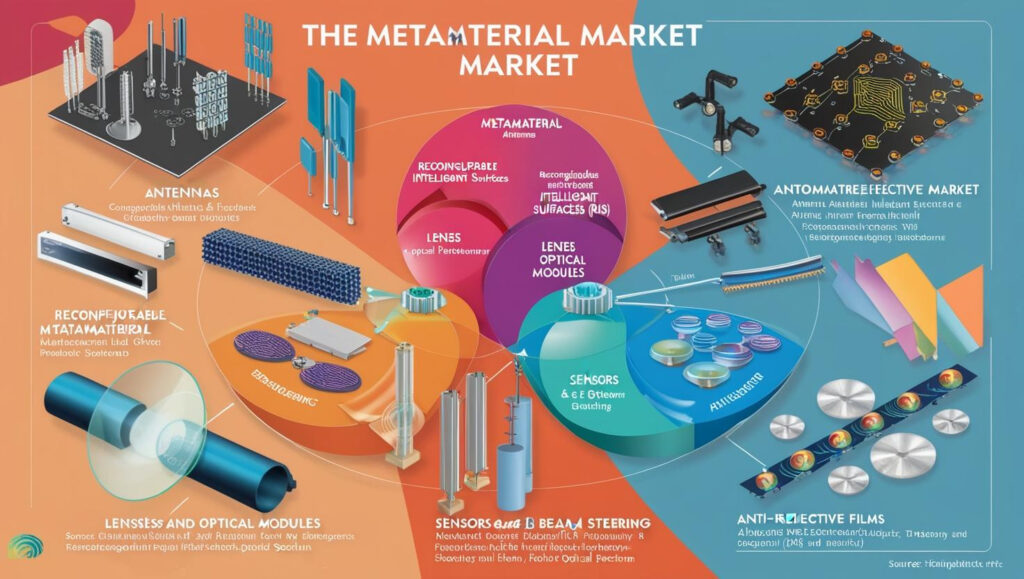3D metamaterials, a revolutionary class of artificially engineered materials, are reshaping multiple industries by enabling unprecedented control over physical properties. Unlike conventional materials, metamaterials derive their unique characteristics from their structural configurations rather than their chemical compositions. The aerospace, medical, and telecommunication sectors have particularly benefited from these innovations, leveraging their advanced capabilities for enhanced performance, efficiency, and new technological breakthroughs.
Download PDF Brochure @ https://www.marketsandmarkets.com/pdfdownloadNew.asp?id=139795737

3D Metamaterials in Aerospace
The aerospace industry has been a primary beneficiary of 3D metamaterials, given their potential to enhance aircraft performance, safety, and fuel efficiency. Some of the key applications in this sector include:
- Lightweight Structural Components 3D metamaterials offer ultra-lightweight yet highly durable materials, significantly reducing the weight of aircraft and spacecraft components. This weight reduction directly contributes to lower fuel consumption and improved maneuverability.
- Radar and Stealth Technology By manipulating electromagnetic waves, metamaterials can make aircraft less detectable by radar. This has profound implications for stealth technology, enhancing the defense capabilities of military aircraft.
- Shock Absorption and Vibration Damping Advanced 3D metamaterials are designed to absorb shocks and vibrations, improving passenger comfort and prolonging the lifespan of aerospace components. These materials are increasingly being integrated into landing gear and fuselage structures.
3D Metamaterials in the Medical Sector
In healthcare, 3D metamaterials are revolutionizing diagnostics, treatment methods, and medical devices. Their ability to control electromagnetic and acoustic waves is proving invaluable for medical applications, including:
- Enhanced Medical Imaging Metamaterials have enabled the development of ultra-high-resolution imaging techniques, including MRI and ultrasound, by focusing and controlling electromagnetic and acoustic waves more precisely.
- Implants and Prosthetics Biocompatible 3D metamaterials are being utilized in the production of implants and prosthetics with enhanced mechanical properties. These materials provide improved integration with biological tissues, reducing the risk of rejection.
- Tissue Engineering The ability to create microstructures that mimic biological tissues has propelled advancements in tissue engineering. 3D metamaterials help in designing scaffolds that promote cell growth and tissue regeneration.
3D Metamaterials in Telecommunications
The telecommunications industry is rapidly integrating 3D metamaterials to improve signal transmission, wireless communications, and network efficiency. Their role in this sector includes:
- Next-Generation Antennas 3D metamaterial-based antennas provide enhanced signal strength, reduced interference, and improved bandwidth efficiency. This is critical for the development of 5G and future 6G networks.
- Electromagnetic Wave Manipulation Metamaterials enable the precise control of electromagnetic waves, allowing for better frequency filtering, improved signal directionality, and increased communication speed.
- Compact and Efficient Circuitry Telecommunication devices are benefiting from the miniaturization capabilities of 3D metamaterials, leading to more compact and efficient communication equipment, including smartphones and satellites.
Future Prospects and Market Growth
The market for 3D metamaterials is expected to expand significantly as industries continue to explore their potential. Research and development efforts are focusing on enhancing scalability, cost-effectiveness, and real-world applications. North America and Europe lead in innovation, while Asia-Pacific is emerging as a key manufacturing hub.
Despite challenges such as production costs and scalability, continuous advancements in 3D printing and nanofabrication are making metamaterials more commercially viable. The increasing demand for lightweight, high-performance materials across aerospace, medical, and telecommunication sectors ensures a promising future for 3D metamaterials.
3D metamaterials are revolutionizing aerospace, medical, and telecommunications industries by enabling innovations previously thought impossible. Their ability to manipulate physical properties at the structural level opens doors to new technological advancements, improved efficiency, and superior performance. As research progresses and applications expand, the transformative potential of 3D metamaterials will only continue to grow, shaping the future of multiple high-tech industries.